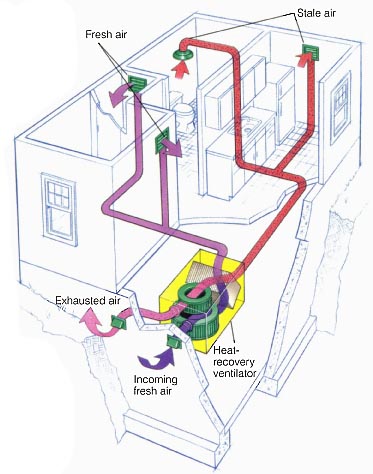Replacing a Dryer Vent
A defective dryer vent can allow drafts, bugs and mice into your home. In less than an hour and at a reasonable price, you can replace it with a sturdier unit that's easier to clean, seals out vermin, reduces the risk of fire and saves energy.
1. Remove the old vent by unscrewing the four corners. Pull out the vent far enough to access the hose clamps and loosen them. Vacuum lint from the old duct.


2. Connect your old ducting to a metal duct collar and insert that into the bottom of the new elbow. Caulk the new elbow mounting base and screw it to the house with galvanized screws.

3. Slide the vent body onto the elbow and screw it to the house with galvanized screws. Drop the vent closer, or cup, onto the vent body and add the weather lid. Clean every 90 days.

Heat-recovery Ventilators
Tightly built homes can experience problems with lingering odors, stale air and high humidity, resulting in damaging condensation. Generally, these problems can be solved with ordinary ventilation or by cracking open a window. If you live in a moderately cold climate with high utility rates, and conventional methods don’t solve your problem, your home may be a candidate for a heat-recovery ventilator (HRV), also called an air-to- air heat exchanger.
Compared to opening a window, an HRV provides continuously controlled ventilation. Heat from stale exhaust air is used to temper the incoming air so fresh air enters your home closer to room temperature; about 70 percent of the heat is transferred. The air streams don’t mingle or contaminate one another, but weave and bypass one another through a series of chambers. Operating costs are about the same as those for a 100-watt lightbulb.
Most HRVs are designed to ventilate the entire home. Typically, four to eight supply-and-return ducts connect to the HRV. The ideal system exhausts air from moisture-laden rooms, such as the kitchen, bathrooms and laundry room, and dumps the fresh air into a closet, hallway or other space where the cooler air and increased movement won’t affect comfort. Adding this kind of whole-house ventilator can be expensive and is normally done by a professional.
It is also possible to install a small, plug-in, single-room HRV on
an exterior wall or in a window. Some models include multiple filters
that clean the air as well. For the most effective air mixing, install
a wall-mounted unit high on an outside wall, but avoid mounting it
up against the ceiling. Keep it away from thermostats and seating areas,
in a spot where some fan noise and cool air movement won’t be a bother.

How a heat-recovery ventilator works. In an HRV, one fan exhausts stale, moisture-laden indoor air while another draws in fresh outside air. Both air streams pass each other, separately, through a core of many thin metal or plastic surfaces. As it passes through the core, exhaust air from the house transmits its heat through core walls or fins to the cooler outside air coming in. A heater can be added to a supply duct in some systems to further warm the incoming air during severely cold weather. In summer-operating mode, HRVs work in reverse. A drain carries away any condensate.
